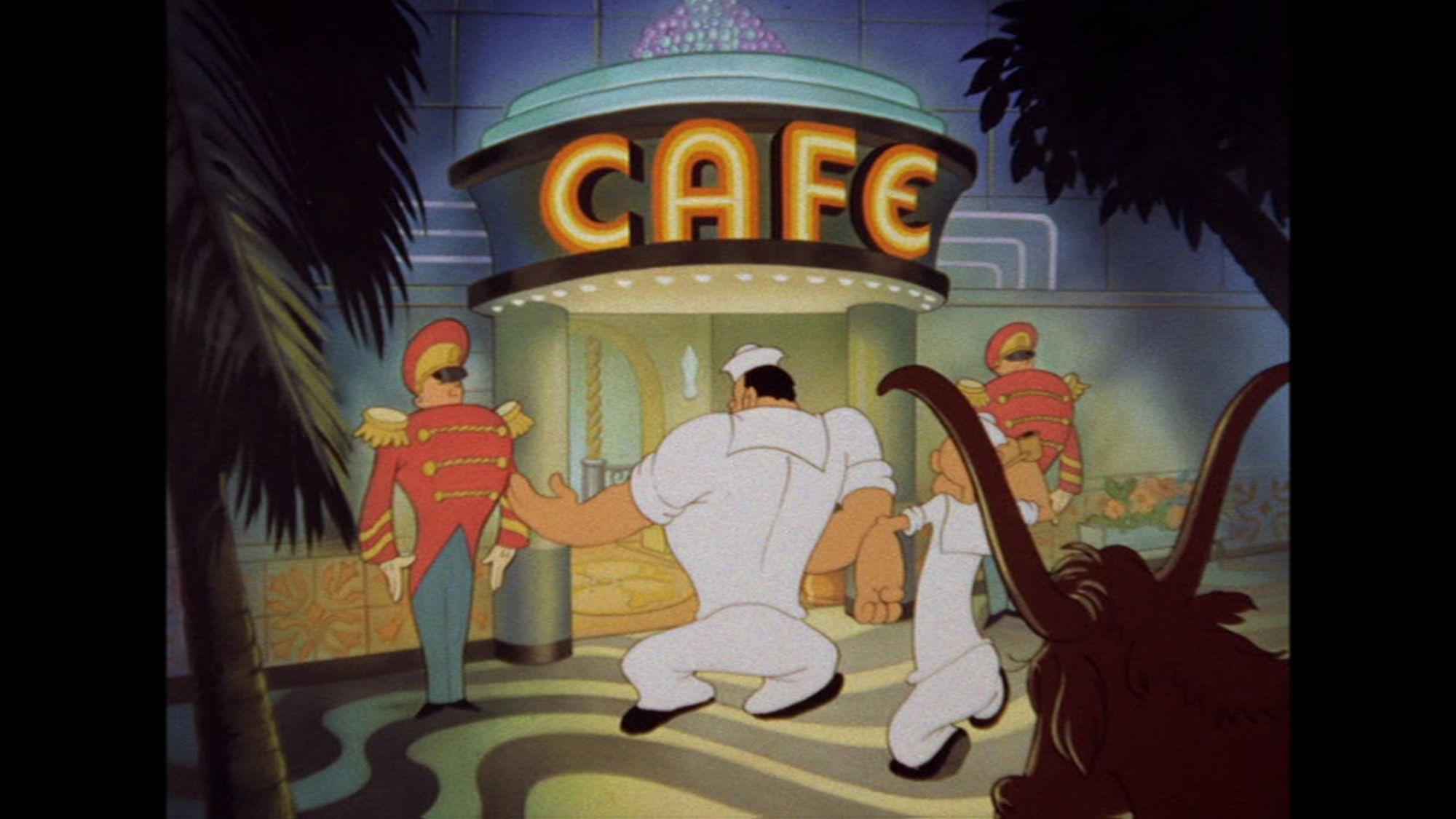A Clubbing We Will Go
In the next sequence, Popeye and Bluto stride brazenly towards a nameless establishment — with the word CAFÉ (sans l’accent aigu) blazoned prominently above the marquee. The boys, strolling shoulder to shoulder, give a U.S. Navy salute to the two uniformed doormen standing at attention and stationed on opposite sides of the entrance.
The viewer’s attention is centered on the main stage. A young couple is outlined in silhouette. The gentleman, at left, politely flicks his cigarette lighter open for an elegant young lady seated to our right. The flame partially illuminates her profile, revealing a charming and, one would imagine, thoroughly sophisticated nightclub-goer.
Moving closer to the main stage, the café’s modest orchestra can be spotted atop a balcony. An extremely large, outsized tambourine — in this case, a pandeiro, the Brazilian equivalent — has been placed against the wall and just below the balcony.
The cartoon’s camera angle now focuses attention on the percussionist’s hands as they work the chocalho, an instrument resembling the maracas. Three musicians swing their clarinets in time to a bouncy samba-like theme (but at a slower pace), one reminiscent of chorinho, a popular music genre at the time. Prominent at right are the drummer’s arms beating a trio of tom-toms.
Suddenly, the focus shifts to the giant pandeiro. Behind it we see the upside-down figure of a lady. The pandeiro flips over to reveal a Carmen Miranda-esque beauty. Why, it’s Olive Oyl, dressed in an exotic baiana (or Bahian) outfit. On her head is a fruit-basket hat, with a necklace of pearls dangling from her neck. She’s wearing a black vest-like blouse with puffy red sleeves; a colorful red, orange and yellow skirt wraps around her torso. Her bare feet are cushioned by sandals, and her toenails are painted red.
With horns blaring, the orchestra blasts out a major-key theme that introduces the sultry singer to our eager swabbies. Not surprisingly, the boys overreact to her physical presence: their eyes automatically widen, while their bodies become rigid with attention.
Bluto sits directly behind Popeye. At Olive’s entrance, Bluto grabs his pal’s neck and covers Popeye’s gaze with his big hands. It doesn’t take a confirmed Freudian to notice that Bluto’s stiffened posture mimics a straight-on erection (that is, in another part of his body) — a natural reaction under the circumstances. Bluto eventually comes down from his “high,” but ends up barking like a trained seal. A passing waiter tosses a fish to the astonished sailor. This scene is almost a direct steal from one in Kickin’ the Conga Round, where the waiter delivers a can of spinach to Popeye’s table.
True to the spirit of the locale, the singer puts her best feet forward. Olive — we assume it’s Olive because of our familiarity with her face and features, even though she’s not identified as such — starts the program off with a Brazilian Portuguese rendition of the song, “Samba Lelê,” the original lyrics of which are given below:
Entrei na roda do samba, samba, samba, samba lelê
Eu sou moleque bamba e agora eu quero ver, o
Entrei na roda do samba, samba, samba, samba lelê
Eu sou moleque bamba e agora eu quero ver
Samba lelê tá doente-te, tá de cabeça quebrada-da
Samba lelê tá doente-te, tá de cabeça quebrada
Eu já sou de fato bamba
Não preciso de muamba
Sou o rei, sou coroado
No batuque sou formado
Entrei na roda do samba, samba, samba, samba lelê
Eu sou moleque bamba e agora eu quero ver, o
Entrei na roda do samba, samba, samba, samba lelê
Eu sou moleque bamba e agora eu quero ver
We’ll get into the specifics, and provide the English translation surrounding this decidedly buoyant and engagingly melodious number, in Part Four of our series. For now, let’s concentrate on the cartoon’s setting and historical background.
The Games People Played
Despite the fact that the actual name of the café where the action takes place is never shown or mentioned, audiences can make an intelligent “leap of faith” guess in identifying the nightclub in question: It’s the renowned Cassino da Urca.
Because of the cartoon café’s proximity to Guanabara Bay, it being situated at the foothills of Sugar Loaf Mountain and part of a peninsula that harbors the much smaller Urca Mountain, this would be the logical place to start.
The classy Cassino da Urca was, at one time, a major showplace for illustrious foreign visitors (for instance, President Roosevelt, Bing Crosby, Josephine Baker, Orson Welles, and the Nicholas Brothers), as well as for locals of financially-elevated means. Too, the Urca was significant as a sought-after leisure spot where, among the multi-talented artists who appeared there, the most conspicuous were Carmen Miranda and her younger sister, Aurora. This makes perfect sense, then, in the cartoon’s depiction of “Olive” as an exotic samba dancer.
Originally a type of beachfront property, the Urca became fashionable as a casino and gambling house during the heyday of such venues as the Copacabana Palace (first established in 1923; closed between 1926 and 1930; reopened in 1932), the Cassino Atlântico (from 1935 on), and ultimately the Cassino da Urca (inaugurated in 1936). At their dizzying heights, author Ruy Castro, in his book A noite do meu bem (“The Night of My Love”), placed the official count at 80 for gambling houses that once flourished throughout the country. Unofficially (and, most likely, illegally), the number ballooned to over a thousand.
There was a time in Brazil, and especially in Rio (before, during, and shortly after the Second World War), where betting on cards and roulette were given pride of place for those in the highest echelons of Brazilian society. Other patrons included performers in the entertainment field, politicians, diplomats, ministers of state, major and minor celebrities, businesspeople, high-class call girls, wealthy Latin Americans (especially Argentines), and vacationing Europeans.
The good times came to an end, however, when Brazil’s long-serving president and dictatorial strongman, Getúlio Vargas (1930-1945), finally left office. His successor, General Eurico Gaspar Dutra, implemented a nationwide decree (which began as a widely circulated rumor) closing down all existing casinos that exploited “games of chance in every region of the country.” The decree took effect on April 30, 1946.
As a result, the Cassino da Urca, along with comparable establishments, suffered huge job losses: from cooks, waiters, dishwashers, telephone operators, hat-check girls, busboys, and publicists to musicians, soloists, acrobats, comics, singers, makeup artists, engineers, set and costume designers, tailors, and dressmakers. Many places continued as resort hotels, the Urca and Copacabana Palace among them. Sadly, the vast assemblage of performers and instrumentalists dwindled to a relative handful, but the music continued on, if in more subdued fashion.
Fortunately for movie audiences, by the time W’ere on Our Way to Rio was launched in the U.S. (on April 21, 1944, to be exact), the casinos in general, and the Urca in particular, were still in full and thriving operation — ergo, its presence as an hospitable “welcome port” for homesick seamen.
Who’s That Girl?
As hinted at in Part Two, decades have passed in wild speculation as to who might have supplied the samba strutting Olive’s vocals. After spending the better part of two-and-a-half years in research and in tracking this elusive individual down, I have been unsuccessful in discovering the name of the person responsible.
With that admission out of the way, I can state, with complete conviction, that the voice provided is definitely not Carmen Miranda’s nor that of her sister Aurora; nor can it be attributed to anyone with the characteristics of a feminine Brazilian voice.
This would have to mean that either Margie Hines or Mae Questel were the actors responsible for voicing Olive, correct? Um, not so fast. In my research, I was able to unearth an abundance of useful information that quantified the exact dates of their participation as Popeye’s girlfriend. The dates also bolstered my suspicions that Olive was not performed by an American voiceover artist.
To begin with, Margie Hines began her association with the Fleischers in 1931. She shared the role of Betty Boop with the above-named Mae Questel until approximately 1932, when Ms. Questel became the official “Boop voice” provider. It was also in 1932 that Ms. Hines signed with the Van Beuren studios. (On a side note, most online websites reference Bonnie Poe, née Clara Rothbart, as having initially done Betty Boop — alongside Questel — as well as sporadic turns as Olive between 1933 and 1935.)
When Max and Dave Fleischer decided, in 1938, to make the move to Miami, Mae refused to uproot herself. Consequently, Margie accepted their offer to relocate and provide Olive’s voice along with that of baby Swee’ Pea. It should be noted, too, that Margie was married at the time to Jack Mercer (Popeye) — their home life must have been anything but routine, to say the least. The couple divorced in 1950.
You may recall that Hines did the “Cuban” version of Olive in 1942’s Kickin’ the Conga Round. She continued her voiceover work for the Fleischers in Florida until the end of 1943, when Paramount bought the brothers out and renamed their company Famous Studios. The move back to midtown Manhattan occurred in early 1944. Margie Hines’ last voiceover as Olive, then, took place with the December 31, 1943 release of The Marry-Go-Round, her final cartoon short.
Shortly afterward, Mae Questel returned to the role of Olive Oyl with the fortuitous May 26, 1944 release of The Anvil Chorus Girl, the first of the newly refurbished New York Popeyes. That would make W’ere on Our Way to Rio, issued the month before on April 21st, the last to be produced in Miami. Both Jack Mercer and Dave Barry (as Bluto) recorded their parts in Florida. There is a conspicuous gap of nearly five months (between December 31, 1943 and May 26, 1944) where neither Hines nor Questel were available for voiceovers. Indeed, all evidence points to this fact.
Unfortunately, most online websites, including IMDb, still credit either Hines, Questel, or the pseudonymous “Uncredited” as having been the singing and speaking voice of Olive in W’ere on Our Way to Rio. I have no objection to “Uncredited,” but the others should make the issue plain: Margie Hines and Mae Questel were not responsible for laying down the vocals for the Brazilian samba dancer.
So who voiced Olive? And why couldn’t it have been either Carmen or Aurora Miranda? They certainly seemed like the logical choices. After all, how many Portuguese speakers were employed by Hollywood at the time? Not many.
The basic problem, for one, is that Carmen was under contract to Twentieth Century-Fox. And the head of Fox Studios happened to be Darryl F. Zanuck. According to various sources, including Ruy Castro’s definitive study, Carmen: Uma biografia, Zanuck would never have permitted Carmen, or any of his staple of stars, to play fast-and-loose with their contracts, only to do lowly voicework at some rival studio, especially one whose subsidiary was on the opposite side of the country — in this case, Famous Studios, owned by Paramount Pictures and the entity that bought the Fleischers out.
Even more obvious, especially to anyone with a decent pair of ears, is for one to make the comparison of Carmen’s singing and speaking voice with the Popeye cartoon version: in truth, they sound nothing alike.
We concede that younger sister Aurora Miranda “might” have been a workable alternative. But after Aurora’s lengthy outing for Walt Disney’s The Three Caballeros (distributed by RKO Radio Pictures, first in Mexico City on December 21, 1944, and subsequently released in the U.S. on February 3, 1945), with a full year of post-production work behind her, the littlest Miranda showed no interest, neither was she approached for the assignment. Besides, Aurora lived in Beverly Hills, along with big sister Carmen.
Aurora Miranda participated in a few Hollywood films of the period. Compared to Carmen, her total output numbered a mere handful of productions, i.e., Universal’s Phantom Lady (January 28, 1944), Warner Bros.’ The Conspirators (October 24, 1944), and Republic Picture’s Brazil (November 30, 1944) and Tell It to a Star (August 16, 1945).
All right, but who did Olive? Possibly somebody who knew Brazilian Portuguese and could sing the language relatively well. But the accent is off. It’s definitely not a carioca (a native of Rio de Janeiro), the enunciation of which stresses the soft “shush” sound. Olive’s speaking voice does have a distinctly Latin tinge, the pronunciation most likely of Cuban or Puerto Rican origin, even Colombian, with the emphasis on a hard “r” sound rather than the softer Portuguese style.
However, the game was finally given away: first, at the phrase “Eu sou moleque bamba e agora eu quero ver” (“I’m a crackerjack at this sort of thing, so let’s see what I can do”); and second, with the English verses to “Broadway Samba,” the American version of “Samba Lelê.” At first, I felt that two voices were hired for this assignment: one for Portuguese, and one for English. Realizing that no studio worth its salt would have the resources to afford two actors for one cartoon short, I concluded that a single voiceover was responsible for the singing and dialogue.
Also, in the original Portuguese lyrics, a true carioca would have “swallowed” the moleque portion, to the point that it would come out sounding like “muh-lek” — a short and crisp absorption of the final syllable. These affectations, as well as that characteristic “shush” sound, are closely associated with the citizens of Rio and which were strongly influenced by their Portuguese colonizers (the original settlers). But here, they are nowhere to be found.
There is also little attention paid to rhythmic accentuation, little flowing of the melodic line, weak adherence to meter or tempo, and a passing respect for quarter notes, eighth notes, and sixteenth notes. An unknown, uncredited artist, or a local Miami resident, with a working knowledge of Brazilian Portuguese and a sense of the Brazilian style of vocalizing, would be the prime candidate.
This makes perfect sense. One source I consulted on JSTOR (entitled “The Cuban Experience in the U.S., 1865-1940: Migration, Community and Identity,” by Gerard E. Poyo for Cuban Studies, Vol. 21, 1991, pp. 19-36 [University of Pittsburgh Press]), indicated that many Cubans came to the Key West and Tampa areas by virtue of the cigar and tobacco industry during the 1930s. Travel back and forth between Cuba and the Florida mainland was all-too common, in particular after the 1933 military uprising (which brought a young Cuban named Desiderio Alberto Arnaz y de Acha III, aka Desi Arnaz, to our shores) and the later 1940 election of President Fulgencio Batista.
It is conceivable, based on the evidence at hand, that Famous Studios took advantage of the available Latin market in and around Miami in Dade County, to include Tampa and quite possibly Key West. For a definitive take on the matter, I conferred with Ruy Castro, who I had corresponded with earlier in reference to Carmen Miranda, samba, and Brazilian-related cultural matters.
“As for the female singer in the cartoon, you’re right — it definitely isn’t Carmen,” Castro pointed out, “nor even a Brazilian singer. It’s some Spanish-born imitator. There were several of them in the USA at the time.” So there you have it.
Despite Ruy’s candid assessment above, my investigation into who voiced Olive in W’ere on Our Way to Rio will continue, as will my analysis of the song “Samba Lelê” and the unexpected revelation of another “Sambalelê” with almost the same melody and lyrics.
Stay tuned!
(End of Part Three)
Read Part Four Here: https://www.brazzil.com/animated-brazil-part-four-two-for-the-price-of-one-conclusion/
Copyright © 2023 by Josmar F. Lopes













